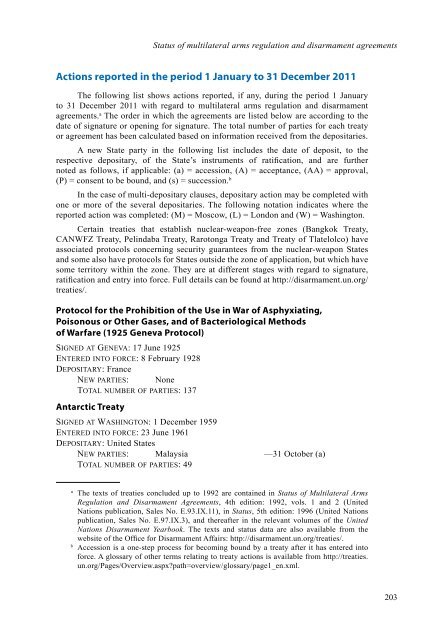DYB2011-Part-II-web
DYB2011-Part-II-web
DYB2011-Part-II-web
Create successful ePaper yourself
Turn your PDF publications into a flip-book with our unique Google optimized e-Paper software.
Status of multilateral arms regulation and disarmament agreements<br />
Actions reported in the period 1 January to 31 December 2011<br />
The following list shows actions reported, if any, during the period 1 January<br />
to 31 December 2011 with regard to multilateral arms regulation and disarmament<br />
agreements. a The order in which the agreements are listed below are according to the<br />
date of signature or opening for signature. The total number of parties for each treaty<br />
or agreement has been calculated based on information received from the depositaries.<br />
A new State party in the following list includes the date of deposit, to the<br />
respective depositary, of the State’s instruments of ratification, and are further<br />
noted as follows, if applicable: (a) = accession, (A) = acceptance, (AA) = approval,<br />
(P) = consent to be bound, and (s) = succession. b<br />
In the case of multi-depositary clauses, depositary action may be completed with<br />
one or more of the several depositaries. The following notation indicates where the<br />
reported action was completed: (M) = Moscow, (L) = London and (W) = Washington.<br />
Certain treaties that establish nuclear-weapon-free zones (Bangkok Treaty,<br />
CANWFZ Treaty, Pelindaba Treaty, Rarotonga Treaty and Treaty of Tlatelolco) have<br />
associated protocols concerning security guarantees from the nuclear-weapon States<br />
and some also have protocols for States outside the zone of application, but which have<br />
some territory within the zone. They are at different stages with regard to signature,<br />
ratification and entry into force. Full details can be found at http://disarmament.un.org/<br />
treaties/.<br />
Protocol for the Prohibition of the Use in War of Asphyxiating,<br />
Poisonous or Other Gases, and of Bacteriological Methods<br />
of Warfare (1925 Geneva Protocol)<br />
Signed at geneva: 17 June 1925<br />
entered into force: 8 February 1928<br />
depoSitary: France<br />
new partieS: None<br />
total number of partieS: 137<br />
Antarctic Treaty<br />
Signed at waShington: 1 December 1959<br />
entered into force: 23 June 1961<br />
depoSitary: United States<br />
new partieS: Malaysia —31 October (a)<br />
total number of partieS: 49<br />
a The texts of treaties concluded up to 1992 are contained in Status of Multilateral Arms<br />
Regulation and Disarmament Agreements, 4th edition: 1992, vols. 1 and 2 (United<br />
Nations publication, Sales No. E.93.IX.11), in Status, 5th edition: 1996 (United Nations<br />
publication, Sales No. E.97.IX.3), and thereafter in the relevant volumes of the United<br />
Nations Disarmament Yearbook. The texts and status data are also available from the<br />
<strong>web</strong>site of the Office for Disarmament Affairs: http://disarmament.un.org/treaties/.<br />
b Accession is a one-step process for becoming bound by a treaty after it has entered into<br />
force. A glossary of other terms relating to treaty actions is available from http://treaties.<br />
un.org/Pages/Overview.aspx?path=overview/glossary/page1_en.xml.<br />
203


